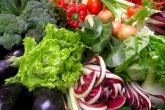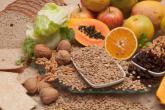Introduction
Functions of water
Food sources
Nutritional requirements
Interesting facts
Introduction
In nature about 135 kinds of water exist. In cells of our organism water is in special form, which we call "structural". Every another fluid, which enters our body, must be processed and purified. Average water content in an adult organism is about 60%. It means an average man, who weighs
72 kg, consists of approximately 45 l of water. In women, because of higher amount of fat in their bodies, percentage of water is a bit lower. One can say organisms of youngest children are filled with water "to the
brim" - the body of a new born contains 75%, and a human embryo almost 98% of water.
|
|
|
Water contained in our organism is constantly exchanged. A healthy organism keeps the balance of fluids under very strict control. In this balance a loss of even 1-2% of water may negatively affect functioning of the whole system. Without food we can survive several weeks, but without water-only several days.
Water brings many benefits. Drinking large amounts of it helps to prevent constipation. In our society, where many people suffer from overweight, the fact water is a drink totally lacking calories (energy) is very relevant.
Water to drink contains many different mineral ingredients. Their level in water-piped water depends on region where it comes from. Bottled water varies from it radically in terms of the content of mineral ingredients.
Functions of water
-
water is essential to keep appropriate volume and pressure of blood in our body,
-
as the main blood ingredient water transports essential nutrients and oxygen to all body cells,
-
it fulfills an important role in organism purifying it from harmful products of metabolism (urine, sweat),
-
it participates in adjusting body temperature - in result of sweating our organism removes excess of warm,
-
water cooperates with digestive enzymes in digestion process and it allows for better absorption of nutrients by organism,
-
water moistens joints, eyeballs, makes swallowing of food bites easier, is a shock-absorber for nervous system and takes part in sound conveying through inner ear,
-
keeping constant proper moisture of lungs water also allows us to breath.
Food sources
The main source of water are liquids and consumed by us food. Every day it provides us with 1/3 of daily rate. Although almost all food products contain water, its highest content possess fruit and vegetables.
Content of water in commonly consumed food and beverages.
| Product | [%] of water |
|---|---|
| Additives | |
| Honey | 20 |
| Mayonaisse | 19 |
| Chocolate unsweetened | 3 |
| Ketchup | 65 |
| Jam | 35 |
| Sugar | 0,2 |
| Salt stics | 6 |
| Meat, eggs, fish | |
| Veal (moderate fat) | 71 |
| Pork (moderate fat) | 42 |
| Beef (moderate fat) | 71 |
| Freshwater fish | 80 |
| Chicken | 74 |
| Eggs | 74 |
| Pork bacon | 42 |
| Beverages | |
| Milk skimmed | 91 |
| Milk whole | 88 |
| Orange juice | 89 |
| Apple juice | 88 |
| Beer | 96 |
| Nuts | |
| Peanuts | 6 |
| Hazelnuts | 5 |
| Walnuts | 4 |
| Fruit | |
| Plums | 83 |
| Melons | 92 |
| Oranges | 86 |
| Apples | 84 |
| Grapes | 83 |
| Mangoes | 82 |
| Bananas | 75 |
| Dates dried | 12 |
| Strawberries | 90 |
| Lemons | 89 |
| Cherries | 83 |
| Pears | 85 |
| Bread, cereals, sweets | |
| Bread white | 40 |
| Bread brown | 42 |
| Cake with fruit | 19 |
| Biscuits | 15 |
| Wheat flour | 14 |
| Soya flour | 7 |
| Semolina | 13 |
| Crisp bread | 6 |
| Cornflakes | 3 |
| Sponge cake with chocolate | 2 |
| Dairy products | |
| Yoghurt (low fat, with fruit) | 78 |
| Kefir | 91 |
| Hard cheese | 38 |
| Cream 20% fat | 73 |
| Fats | |
| Margarine | 14 |
| Butter | 16 |
| Cooking oil | 0 |
| Pork fat | 9 |
| Vegetables and mushrooms | |
| Courgette (zucchini) | 93 |
| Lettuce | 95 |
| Tomatoes | 94 |
| Mushrooms | 93 |
| Carrots | 89 |
| Potatoes | 77 |
| Green peas | 75 |
| French fries (chips) | 57 |
| Cucumbers | 96 |
| Onions | 91 |
Nutritional requirements
Every day we lose average 2,6 l of water through urinary system, with faces, sweat and during breathing. This amount is bigger in hot, dry and windy days or after vigorous exercises. Every water loss must be complemented at once, that is why generally it is recommended for the adults to drink about 1,5-2 liters of liquids every day, and together with water contained in food about 3-3,5 l daily.
Generally the adults approximately need 1 ml of water for 1 kcal of consumed energy, although this amount changes and it depends on sweating intensity and can reach up to 1,5 ml/kcal. Water losses in organism also increase during long-lasting illness, vomiting, diarrhea, fever and scalding, that is why it is important for us to drink much water in such cases. What curious, so-called "solid" food provides us with significant quantity of water: approximately 1/3 of liquids we take. Vegetables contain almost 95% of water and white bread about 37%. Water is also produced in our organism as metabolism product, on an average 250 ml a day.
RDA for various life stage groups - total water includes all water contained in food, beverages, and drinking water
| Life stage group |
Water |
|---|---|
|
Recommended Dietary Allowances (RDA) [l/day] |
|
| Infants 0-6 months | 0,7 |
| Infants 6-12 months | 0,8 |
| Children 1-3 years | 1,3 |
| Children 4-8 years | 1,7 |
| Males 9-13 years | 2,4 |
| Males 14-18 years | 3,3 |
| Males 19-30 years | 3,7 |
| Males 31-50 years | 3,7 |
| Males 51-70 years | 3,7 |
| Males > 70 years | 3,7 |
| Females 9-13 years | 2,1 |
| Females 14-18 years | 2,3 |
| Females 19-30 years | 2,7 |
| Females 31-50 years | 2,7 |
| Females 51-70 years | 2,7 |
| Females > 70 years | 2,7 |
| Pregnancy ? 18 years | 3,0 |
| Pregnancy 19-30 years | 3,0 |
| Pregnancy 31-50 years | 3,0 |
| Lactation ? 18 years | 3,8 |
| Lactation 19-30 years | 3,8 |
| Lactation 31-50 years | 3,8 |
Interesting facts
-
some medicines called diuretics cause loss of water with urine. Alcohol, tea and coffee also have gently diuretic action and their too high consumption may contribute to organism dehydration,
-
camels can trek so long through desert without water drinking thanks fat reserves stored in their humps. When this fat is used by organism as energy source, significant amount of water is created as by-product of fat metabolism,
-
every day only with exhaled air we lose from 400 to 500 ml of water, and during heat even more,
-
it is possible to consume too much water. Effectiveness of our kidneys is about 0,6-1,5 l of urine per hour. If one drinks more than these amounts, or because of illness reasons one cannot get rid of water adequately fast from our organism, phenomenon of overhydration of organism. Its symptoms are e.g. nausea, vomiting, breathlessness, swelling, increasing disorder of consciousness, muscle spasms, convulsions and even in extreme cases coma,
-
there are proofs that hard water may be more healthy than soft water because at area where it occurs lower lapsing into circulatory system diseases has been noticed,
-
water, which does not meet hygiene standards, happens to be the reason of epidemic growth,
-
mineral water in comparison with tap water is much clearer in chemical respect, and moreover it provides additional amounts of mineral ingredients e.g. calcium. It is also safer for health and has better taste,
-
nervous centers in brain control the feeling of thirst and the amount of urine our organism produces. Some experts believe that in the moment we feel thirst our organism is already in state of slight dehydration. If we ignore those signals, brain will send information to kidneys to increase reflexive absorption of water and reduce urine production. So to drink water we ought not to wait until we feel thirst,
-
the more fat in your body the less percentage of water it contains. Woman's body consists of about 60% and man's one of about 65% of water because naturally woman's body contains more fat. The percentage of water in organism can drop with age even to 50%,
-
water from some regions has high level of fluorine. Excess of this element, especially in children, may cause occurrence of characteristic spots on teeth. Water of low fluorine content may on the other hand be conducive to decay growth.

















